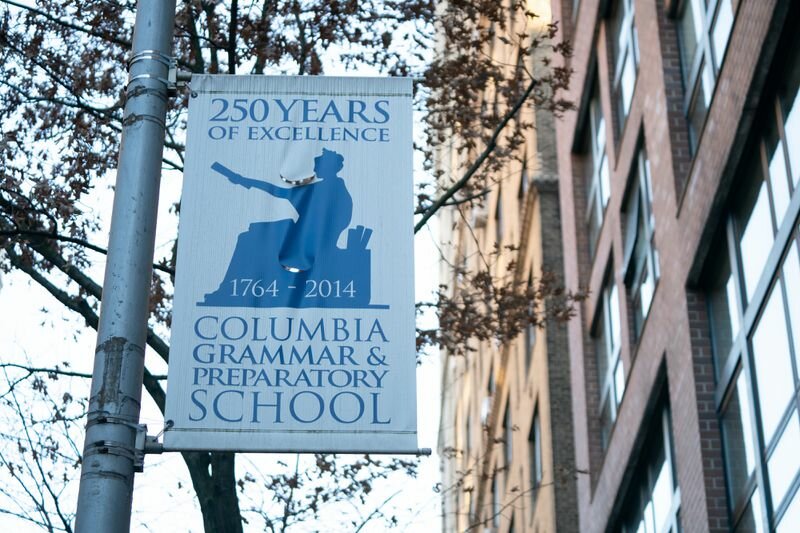
In 2017, the first year of the state-sponsored grant, the Upper West Side stalwart Columbia Grammar & Preparatory School, which charges north of $52,000 a year and where President Trump’s son Barron attended class, got nearly $100,000 in state money to pay for teachers of science, technology, and math — known as “STEM” programs, according to state records. (Barry Williams/for New York Daily News)
By Michael Elsen-Rooney
Originally published by the New York Daily News on February 3, 2020
Wealthy private schools did the math — and got a little richer.
A fast-growing New York state program that funds math and science teacher salaries at private schools paid out hundreds of thousands of dollars to some of the city’s priciest private schools that can charge over $50,000 a year for tuition, the Daily News has learned.
In 2017, the first year of the state-sponsored grant, the Upper West Side stalwart Columbia Grammar & Preparatory School, which charges north of $52,000 a year and where President Trump’s son Barron attended class, got nearly $100,000 in state money to pay for teachers of science, technology, and math — known as “STEM” programs, according to state records.
The pot of gold has only grown since then ― from $5 million in total funding in 2017, to $15 million in 2018 and $30 million last fiscal year. Gov. Cuomo proposed $35 million for the program in his latest executive budget.
“It’s outrageous that a number of these wealthy schools are getting this money,” said City Councilman Danny Dromm (D – Queens), an ardent critic of public handouts for private schools.
“We have plenty of students in the public schools who would benefit from that type of investment. It’s short-changing our public school students,” he said, noting that city public schools are still short more than $1 billion on money promised by the state’s school funding formula.
The state subsidy, called the Math, Science & Technology Teachers in Religious and Independent Schools Grant, emerged in the 2017 budget after a years-long lobbying effort led by Teach-NYS – an offshoot of the Orthodox Union, a nationwide Orthodox Jewish organization. Schools apply for state reimbursement after hiring sought-after instructors.
Cuomo’s budget spokesman, Freeman Klopott, declared “there is no diversion as we add $826 million for education spending — with 85% of the Foundation Aid increase targeting poor schools — raising overall funding to an all time high of $28.5 billion.”
“We believe all kids deserve access to a high quality STEM education — as does the legislature who voted for this program year after year — but this program to encourage non-public schools to teach the programs we believe to be important is a drop in the budget compared to our funding of high needs schools,” Klopott said.
Maury Litwack, the group’s executive director, argues the aid benefits private schools struggling to hire STEM teachers — and the state economy.
“There is a real struggle to fill tech jobs in New York,” Litwack said.
Almost 400 private schools had their hands out for a state reimbursement for the salaries of 1,500 math and science teachers in 2017, which would have cost over $80 million. The state only allocated $5 million for the program, however, so each school got a fraction of their total request.
The vast majority of the beneficiaries – about 90% – were religious schools, including ones with “high scholarship needs, and schools that desperately need this program to hire and retain teachers,” Litwack said.
James Cultrara, Executive Secretary of the state Council of Catholic School Superintendents, declared the funding has been a “shot in the arm” for parochial schools struggling to offer cutting-edge classes.
“The general reality is Catholic schools have great difficulty in paying our teachers what they’re truly worth,” he said.
And then there’s Columbia Prep, whose endowment reportedly reached $25 million in 2008. Also among the well-heeled city private schools that shook the money tree: Little Red School House, a revered, $47,000-a-year private school in SoHo that got $22,000 in state support for teacher salaries.
Neither of the private schools returned phone calls.
Bay Ridge Prep, which charges up to $34k in tuition a year, got $18,000 in state funding, and the Chapin and Blue Schools in Manhattan – which both have a sticker price near $50,000 — pocketed $5,000 and $7,000 a piece.
Ten percent of the 383 schools that got funding in 2017 were non-denominational private schools, 33% were Jewish, 54% were Christian, and 3% were Muslim.
State officials haven’t yet doled out the grant money for the 2018-19 school year, but a source familiar with the program said a similar number of schools applied as in the previous year. That means each school’s 2017 funding stands to triple since the state pot expanded from $5 to $15 million.
This school year, $30 million is available to private schools to defray teacher salaries.
The STEM grant program isn’t the first public subsidy for private schools that’s raised eyebrows. A city program that pays for unarmed security guards at private schools drew similar howls.
Litwack, the leader of the STEM grant lobbying effort, said he “wouldn’t deprive any institution seeking funding” for STEM teachers. “When a program is partially funded and the demand is as high as it is, we have bigger questions to answer than that,” he added.
But critics say the steadily expanding program diverts already resources from an already-strained public system.
Private schools “have to make up the funding as required by state law and that’s their obligation to do it,” Dromm said. “It’s a shadow voucher system that’s been going on now for a while.”
Read more here.
